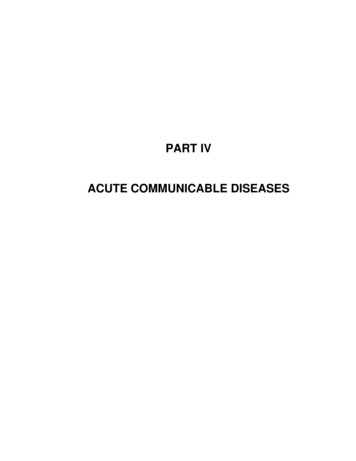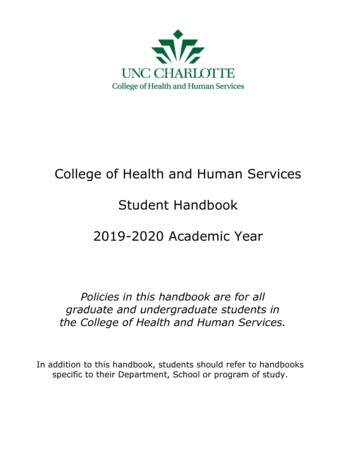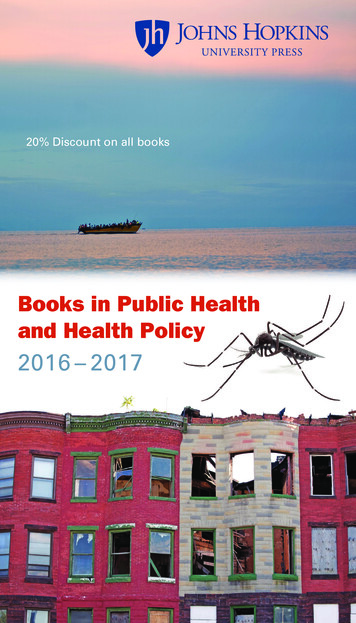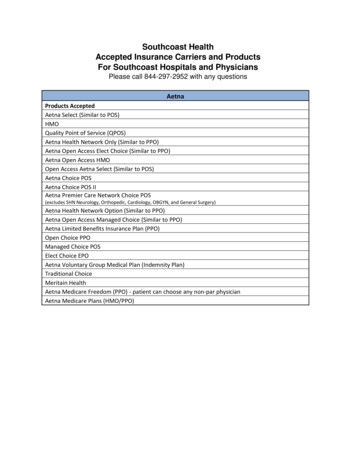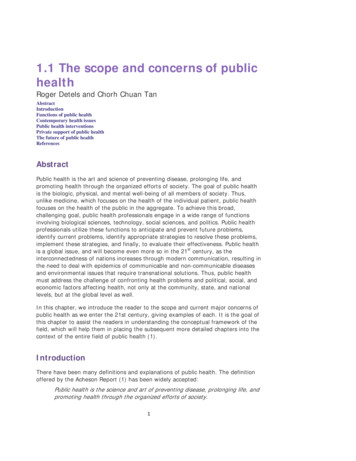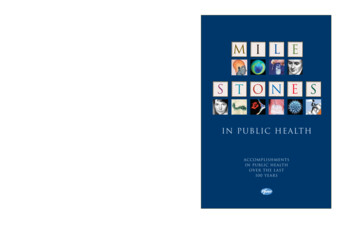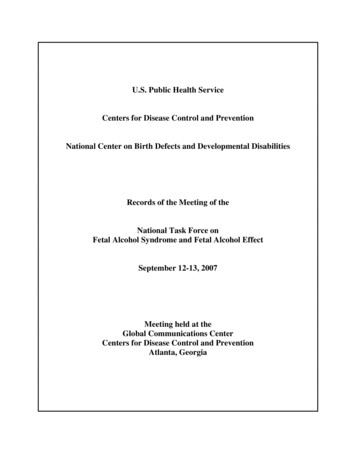
Transcription
U.S. Public Health ServiceCenters for Disease Control and PreventionNational Center on Birth Defects and Developmental DisabilitiesRecords of the Meeting of theNational Task Force onFetal Alcohol Syndrome and Fetal Alcohol EffectSeptember 12-13, 2007Meeting held at theGlobal Communications CenterCenters for Disease Control and PreventionAtlanta, Georgia
Table of ContentsWednesday, September 12, 2007Call to Order . 3Introduction of Task Force Members, Liaisons, and Attendees . 3Opening Remarks. 5Overview of the Prevention Report . 5Deliberations on the Prevention Report and Recommendations. 13Report from the NTFFAS Post-Exposure Working Group. 34Discussion and Task Force Vote on “Call to Action” Report. 41Recognition of Task Force and Liaison Members . 42Dissemination of Task Force Products . 42Public Comments / Adjourn. 44Thursday, September 13, 2007Call to Order / Recap of Previous Day’s Discussions. 44FEDERAL UPDATES:Interagency Coordinating Committee on Fetal Alcohol Syndrome. 44National Institute on Alcohol Abuse and Alcoholism . 48Centers for Disease Control and Prevention . 52Substance Abuse and Mental Health Services Administration. 54LIAISON UPDATES:American College of Obstetricians and Gynecologists . 55American Academy of Pediatrics . 56The Arc . 57Center for Science in the Public Interest. 57March of Dimes . 61National Organization on Fetal Alcohol Syndrome. 65NEXT STEPS:Potential Collaborative Activities after the Task Force Sunset . 65Final Task Force Conference Call, October 2007. 65Closing Remarks. 66Public Comment /Adjourn . 66National Task Force on FAS/FAE, September 2007 Meeting Minutes2
Centers for Disease Control and PreventionNational Center on Birth Defects and Developmental DisabilitiesNational Task Force on Fetal Alcohol Syndrome and Fetal Alcohol EffectMinutes of the MeetingSeptember 12-13, 2007A meeting of the National Task Force on Fetal Alcohol Syndrome (FAS) and Fetal AlcoholEffect (FAE) was convened on September 12-13, 2007 in Atlanta, GA by the Centers for DiseaseControl and Prevention’s (CDC) National Center on Birth Defects and DevelopmentalDisabilities (NCBDDD).Wednesday, September 12, 2007Call to OrderJean A. Wright, MD, MBA, Chair, called the meeting to order at 9:00 a.m. and welcomed thosepresent. She thanked everyone for attending the final face-to-face meeting of the National TaskForce on Fetal Alcohol Syndrome and Fetal Alcohol Effect (NTFFAS).Introduction of Task Force Members, Liaisons, and Attendees:Chair:Jean A. Wright, MD, MBA, Backus Children’s Hospital,Savannah, GAActing Executive Secretary: R. Louise Floyd, DSN, RN, Fetal Alcohol Syndrome PreventionTeam, DBDDD, NCBDDD, CDCDesignated Federal Official: Mary Kate Weber, MPH, Fetal Alcohol Syndrome PreventionTeam, DBDDD, NCBDDD, CDCStanding Member:Kenneth R. Warren, PhD, National Institute on Alcohol Abuseand Alcoholism (NIAAA), National Institutes of Health (NIH)Washington, DCTask Force Members Present:Kristen L. Barry, PhD, Department of Veterans Affairs and the University of Michigan, AnnArbor, MIJames E. Berner, MD, Alaska Native Tribal Health Consortium, Anchorage, AKCarole W. Brown, EdD, Catholic University of America, Washington, DCGrace Chang, MD, MPH, Brigham and Women’s Hospital, Boston, MAMary C. DeJoseph, DO, Philadelphia College of Osteopathic Medicine, Philadelphia, PALisa A. Miller, MD, MSPH, Department of Public Health and Environment, Denver, COColleen A. Morris, MD, University of Nevada School of Medicine, Las Vegas, NVMary J. O’Connor, PhD, ABPP, David Geffen School of Medicine at the University ofCalifornia, Los Angeles (UCLA), Los Angeles, CA (via phone)Melinda M. Ohlemiller, BA, MA, Saint Louis Arc and parent of a twelve-year-old with FAS,St. Louis, MOHeather Carmichael Olson, PhD, University of Washington FAS Diagnostic Clinic,Washington State FAS Diagnostic and Prevention Network, Seattle, WANational Task Force on FAS/FAE, September 2007 Meeting Minutes3
Liaison Representatives Present:American Academy of Pediatrics (AAP): George Brenneman, MD, FAAPAmerican College of Obstetrics and Gynecology (ACOG): Robert J. Sokol, MD, Department ofObstetrics and Gynecology, C.S. Mott Center for Human Growth and Development, Schoolof Medicine, Wayne State University, Detroit, MIMarch of Dimes (MOD): Karla Damus, PhD, Washington, DCThe Arc: Sharon Davis, PhD, Health Promotion and Disability Prevention Committee, SilverSprings, MDCenter for Science in the Public Interest (CSPI): George A. Hacker, JD, Alcohol Policy Project,Washington, DCLiaison Representatives Absent:National Organization on Fetal Alcohol Syndrome (NOFAS): Kathleen T. Mitchell, MHS,LCADC, Washington, DCOther Attendees:Kendall Anderson, MPH, Deputy Chief, Prevention Research Branch, DBDDD, NCBDDD,CDCJacquelyn Bertrand, PhD, Developmental Psychologist, FAS Prevention Team, PRB, DBDDD,NCBDDD, CDCColeen Boyle, PhD, Director, DBDDD, NCBDDD, CDCElizabeth Parra Dang, MPH, Behavioral Scientist, FAS Prevention Team, PRB, DBDDD,NCBDDD, CDCClark Denny, PhD, Epidemiologist, FAS Prevention Team, PRB, DBDDD, NCBDDD, CDCYvette Dominique, Battelle ContractorPatricia P. Green, MSPH, Epidemiologist, FAS Prevention Team, PRBM DBDDD, NCBDDD,CDCMelissa Hogan, Battelle ContractorCatherine A. Hutsell, Health Education Specialist, FAS Prevention Team, PRB, DBDDD,NCBDDD, CDCTreana Johnson-James, Battelle ContractorKaren Howell, MD, Emory University School of MedicineEileen Miles, MPH, Battelle ContractorChristine E. Prue, MSPH, PhD, Chief, Prevention Research Branch, DBDDD, NCBDDD, CDCEsther Sumartojo, PhD, MSc, Associate Director for Science and Public Health, NCBDDD,CDCJames Tsai, MD, Epidemiologist, FAS Prevention Team, PRB, DBDDD, NCBDDD, CDCMyra Tucker, Division of Adult and Community Health, NCCDPHP, CDCLeslie O’Leary, PhD, Epidemiologist, Surveillance Team, Birth Defects Branch, DBDDD,NCBDDD, CDCJacqueline Vowell, Committee Management Specialist, FAS Prevention Team, PRB, DBDDD,NCBDDD, CDCStephanie Wallace, Writer-EditorNational Task Force on FAS/FAE, September 2007 Meeting Minutes4
Opening RemarksR. Louise Floyd, DSN, RNDr. Louise Floyd also thanked everyone for their presence at this final meeting. She expressedher gratitude to the members of the team who helped put together the meeting materials. Shenoted that the group would discuss two excellent documents during this meeting and stressed theimportance of fully vetting both, given that the NTFFAS would have only one additionalopportunity at the upcoming conference call in October to finalize these documents.Overview of the Prevention ReportMary Kate Weber, MPHMs. Weber indicated that she was asked to speak on behalf of the Prevention Working Group topresent an overview of the draft report titled Reducing Alcohol-Exposed Pregnancies. Shepointed out that that this report was the result of the effort of several Task Force members andconsultants who are experts on many of the topics addressed within the report: Task Forcemembers: Lisa Miller, MD, MSPH; Raul Caetano, MD, PhD, MPH; Mary O’Connor, PhD;Grace Chang, MD, MPH; Kristen Barry, PhD; and Mary DeJoseph, DO. Research TriangleInstitute (RTI) International staff members: Frank DeStefano, MD, MPH; Suzanne Dolina,MPH; and Kimberly Leeks, PhD, MPH. CDC staff members: Louise Floyd, DSN, RN; andMary Kate Weber, MPH. Ms. Weber expressed gratitude to the Task Force members and RTIstaff for pulling this draft report together in a very short period of time.With respect to the background of the report, Ms. Weber indicated that around 2004, a TaskForce Working Group on Prevention was established. The main goal of the working group wasto develop a report on evidence-based strategies for FASD prevention. Several subsequent TaskForce meetings focused on prevention, highlighting both population-based and individual-levelstrategies. Additionally, the Task Force began to collaborate with CDC’s Community Guidestaff who works with the U.S. Community Preventive Services Task Force (USPSTF) to developrecommendations on prevention on a wide array of health topics, alcohol misuse being one ofthese. Thus, a collaboration was formed with the Community Guide through a contract with RTIInternational. The Task Force Working Group worked with RTI in the development of a reportfocused on community-based FASD interventions that was presented at the last Task Forcemeeting. The findings from the RTI report, along with information presented by Dr. EvelynWhitlock on the recommendations of the USPSTF on behavioral counseling interventions foralcohol misuse, laid the groundwork for the report to be presented. Also, at the last Task Forcemeeting, a writing group was formed to help summarize and pull together the current evidenceon FASD prevention strategies.Ms. Weber indicated that Task Force members should have received a copy of the most recentversion of the report in the packet they received upon arrival. A few minor changes were madeto the alcohol dependence section and a draft executive summary was also added to the newestversion. The main goals of the report are to: review evidence-based prevention strategies;develop recommendations based on the evidence; identify prevention research and practice gaps;and propose future research directions.National Task Force on FAS/FAE, September 2007 Meeting Minutes5
Essentially the report contains the following sections: Executive SummaryBackground & Epidemiological Overviewo Scope of the problemo Commitment to FASD preventiono Examples of existing prevention guidelines and recommendationsAlcohol ScreeningCurrent Evidence (the main section)Universal PreventionSelective & Indicated Preventiono Brief Interventions: General Population, Pregnant and Non-Pregnant Womeno Indicated Interventions: Women with alcohol dependenceRecommendations (follow each of the sub-sections within the Current Evidence section)Potential Strategies for Future ResearchSummaryAs the data indicates, alcohol use during pregnancy continues to be a serious public healthproblem. One in eight pregnant women drink alcohol during pregnancy and 2% of them bingedrink. Also, many pregnant women do not know they are pregnant until the second or thirdmonth, so they may continue to drink at risk levels and almost 50% of pregnancies in the UnitedStates are unplanned. With data from the Behavioral Risk Factor Surveillance System (BRFSS)survey’s 2002 family planning module, CDC examined alcohol consumption patterns of womenwho might become pregnant. Fifty-four percent of these women reported any alcohol use (in thepast 30 days). More striking is that 12.4% of these women report binge drinking, which makesthem at particular risk for an alcohol-exposed pregnancy (AEP). Ms. Weber noted that thesedata only report on women reporting no contraception use. Women using ineffective birthcontrol methods were not included, primarily because this would require more in-depthquestioning on how woman use their birth control method. Hence, these data are most likelyunderestimating the true number of women at risk. Overall, these data indicate that reducingalcohol-exposed pregnancies is an important public health problem and emphasize theimportance of developing effective strategies to address the diverse needs of women ofchildbearing age: those who are pregnant, who are trying to become pregnant or who mightbecome pregnant.While the data do not paint a good picture, there is some good news. FASDs are preventable.Progress has been made in the field of prevention over the past 30 years, effective strategies toprevent alcohol-exposed pregnancies exist, and it is time to spread the word about what works.More good news is that there has been a concerted effort to address prevention of FASDs at thefederal level. There are a variety of federal prevention efforts that have been underway since1973. Funding has mainly gone to NIAAA, CDC, and the Substance Abuse and Mental HealthServices Administration (SAMHSA). These included the creation of the InteragencyCoordinating Committee on Fetal Alcohol Syndrome (ICCFAS) in 1996, which bought variousfederal agencies together to collaborate and share ideas across agencies on FAS. Later, theNational Task Force was created, which included representatives in the fields of FASD andalcohol from across disciplines and organizations, including professional organizations andNational Task Force on FAS/FAE, September 2007 Meeting Minutes6
parent groups. In 2002, the Task Force released its first recommendations. Among these werespecific recommendations on prevention and the Prevention Working Group also was created. Inaddition, in 2001, SAMHSA’s FASD Center for Excellence was established which recently hasbeen re-funded and will continue into the future.Before getting into the evidence, the writing group felt that it was important to highlight some ofthe prevention recommendations and guidelines that are already in the field in terms ofpreventing AEPs. The 1996 Institute of Medicine (IOM) report looked at FAS comprehensivelyin terms of the epidemiology, diagnosis, prevention, and treatment aspects of the condition andincludes recommendations specific to prevention. The CDC referral and diagnostic guidelinesalso devote a section to prevention, emphasizing the importance of screening and briefintervention. The American Academy of Pediatrics (AAP) and the American College ofObstetrics and Gynecology (ACOG) also have published guidelines related to alcohol use inpregnancy. ACOG also recently developed a toolkit providing guidelines to health professionalson how to screen and intervene with women of childbearing age, including both pregnant andnon-pregnant women. Finally, the Surgeon General’s Advisory, which this Task Force and itsmembers were instrumental in moving forward, was released in 2005, providing guidance onpreventing FASD to all women of childbearing age.Also highlighted in the prevention report are a number of other broader-based recommendationsand efforts focused on screening and brief intervention. Based on a systematic review of theliterature, the Unites States Preventive Services Task Force (USPSTF) recommended that healthproviders screen all adult patients in primary care settings for alcohol misuse and providecounseling interventions for those identified as risky or harmful drinkers. This guide, developedin a collaborative effort between CDC and the National Business Group on Health, translatesclinical guidelines and medical evidence to assist large employers with the information to helpthem select, define, and implement preventive medical benefits in over 40 different health areas.This purchaser’s guide includes support for alcohol screening for adults and for women who arepregnant or planning a pregnancy. In addition, since January 2007, doctors have been able to billMedicaid for alcohol and drug screening and brief intervention services using the new Center forMedicare and Medicaid billing codes. Also, SAMHSA currently funds 17 state-based screening,brief intervention, referral, and treatment programs (11 SBI cooperative agreements and 12college-based SBI programs).Another section of the prevention report focuses on alcohol screening. Before intervening with awoman at risk for an AEP, screening for alcohol use is essential. Screening with a valid tool isrecommended. There are a variety of tools to choose from; however, they have not all beeneffective with female populations. Currently, the recommended screening instruments foridentifying pregnant and non-pregnant risk drinkers include the T-ACE, TWEAK, and AUDIT-Cfor women. The CRAFFT is a tool used to assess substance use problems with adolescents.These tools, including the specific screening questions, are outlined in the report because thegroup felt that the reader should have the actual questions at their disposal right away.In thinking about the issue of prevention, early on the Prevention Working Group agreed on thefollowing assumptions: 1) strategies must be evidence-based or considered best practice; 2)consideration should be given to the full spectrum of prevention strategies; and 3) all women ofchildbearing age at risk for an AEP should be targeted. The effective prevention strategiesNational Task Force on FAS/FAE, September 2007 Meeting Minutes7
outlined in this report are categorized using the prevention framework previously adapted by theIOM Committee to Study Fetal Alcohol Syndrome in 1996. The following framework helpedguide the writing group’s thinking in how they approached outlining the evidence:UniversalSelectiveIndicatedTargeted to general public;focus on reductions in percapita alcohol consumptionDirected at populations whomay be at greater risk for anoutcome because they aremembers of a group foundto be at greater risk than thegeneral populationWarning labels, taxation on alcohol,limited hours of saleTargets the highest riskindividualsWomen who have had a previousalcohol-exposed pregnancy, womendrinking at high levels and pregnant;women who are already dependent andneed specialized treatmentScreening of women of childbearingage, targeted programs to women ofchildbearing ageWith respect to universal prevention, examples of population-based efforts include theCommunity Guide, which is coordinated by CDC. The Guide conducts systematic reviews ofpopulation-based programs. The Task Force on Community Preventive Services makesrecommendations on the use of population-based public health programs and policies based onthe reviews conducted by the Guide teams to identify what practices have worked to improvehealth, and to identify those that have not been researched adequately to help inform the publichealth agenda. The Task Force on Community Preventive Services recently selected “excessivealcohol use” as a priority topic area for systematic review. Although the reviews are not yetcompleted, proposed interventions to be evaluated include: enhanced enforcement of lawsprohibiting illegal sale of alcohol to minors, retail outlet density and zoning restriction, limitingalcohol advertising exposure, and increased alcohol taxes. In 2003, the World HealthOrganization (WHO) Alcohol and Public Policy Group (APPG) conducted an extensive reviewof the literature that focused on 31 alcohol policy-relevant prevention strategies andinterventions, many of which were population-based. These were further classified into sevencategories: 1) regulating physical availability of alcohol, 2) pricing and taxation, 3) altering thedrinking context, 4) education and persuasion, 5) regulating alcohol promotion, 6) drinkingdriving countermeasures, and 7) treatment and early intervention.The evidence on universal interventions in actually preventing FAS or FASD, however, is quitelimited. A few examples of studies using a universal approach to prevent FASDs include thefollowing: Bowerman (1997) assessed the use of an alcohol ban on alcohol possession in an Alaskancommunity. He found a significant decrease noted in first trimester alcohol abuse (32%).Regarding labeling, Hankin (1993, 1996) looked at alcohol consumption rates by innercity African American women attending a prenatal care clinic. After implementation ofthe label law, there was a significant decrease among non-risk drinkers; however, noNational Task Force on FAS/FAE, September 2007 Meeting Minutes8
decrease in alcohol consumption was detected among heavier drinkers, which suggestedthat this may have a limited impact on women at greatest risk for having a child with anFASD.Glik (2001) published a study of a mass media (e.g., posters and tear-off cards) whichfound an overall increase in knowledge and awareness of the risks of alcohol use duringpregnancy among African American and Latina adolescents.Ms. Weber noted that while the recommendations were in draft form at this time, the groupwould spend more time during this meeting continuing to develop them, possibly adding others.She reviewed the recommendations, which are as follows:1. Better measure the impact of universal prevention strategies and policies on women’s alcoholuse and pregnancy outcomes.2. Development of better methods for evaluation of strategies not yet deemed effective due tolack of evidence (e.g. point of service, school-based) but play an integral part in efforts toprevent FASDs in terms of education and public awareness.Selective and indicated prevention strategies are more targeted and intensive compared touniversal strategies and fall along a continuum based on the severity of the problem. Inreviewing the literature, the science basically led the group to brief alcohol interventions as themost promising approach to reducing alcohol use. The effectiveness of brief interventions hasbeen demonstrated in multiple settings and with specific population groups. Those highlightedin the draft report include: The general population (e.g., primary care, emergency, and collegesettings); pregnant women; and preconceptional women. Seven systematic reviews of briefintervention (BI) are cited in the report. The most recent systematic review done in the area ofBI in primary care settings was the 2004 U.S. Preventive Services Task Force (USPSTF) reporton screening and behavioral counseling interventions for alcohol misuse. The author of thisreport presented at the last NTFFAS meeting. The review, which identified 12 studies that metthe necessary criteria, found good evidence that screening can accurately identify patients at riskand brief interventions with follow-up produce small to moderate reductions in alcohol use thatare sustained over 6-12 month periods or longer. The NTFFAS could not recommend screeningfor adolescents, given that the evidence at the time was limited.Some of the key elements of the brief interventions identified in the USPSTF review, based onDr. Whitlock’s presentation during the last meeting, are that the studies in this review weretypically brief, multi-contact interventions with repeat visits that extended over 2-12 months.Goal setting was often used as a tool within the interventions along with feedback, advice, andon-going assistance. The USPSTF review also stressed that additional staff or systems supportwere required for many of these studies. Staff training was provided ranging from 15 minutes to2.5 hours. Research staff often conducted the assessments to identify at-risk alcohol usersoutside of the routine clinical encounter and also often summarizing assessment results andsupplied intervention materials and follow up staffing. Additionally, the availability of referralsources for more seriously affected drinkers is an implicit need. The topic of “alcohol misuse”has been prioritized by the USPSTF for updating. The review for this will begin in late 2007 orearly 2008.National Task Force on FAS/FAE, September 2007 Meeting Minutes9
Most of the interventions in emergency medical settings focus on patients presenting withinjuries. The emergency medical setting essentially offers a window of opportunity when theindividual may be more vulnerable and more open to seeing the connection between currentconsequences and his / her drinking behaviors and perhaps may be more motivated for change.A recent systematic review identified four studies that demonstrated positive outcomes foremergency department-based interventions. For those who received the interventions, there werereported reductions in alcohol use and heavy episodic drinking. Also, two of the studies showedthat BIs in emergency rooms were effective at increasing referrals to treatment. Overall, studiesalso reported lower incidence in alcohol-related injuries, drinking and driving, and alcoholrelated problems. BIs in emergency medical settings have been shown to be effective. This maybe a potential area for further research in reaching women of childbearing age.Drinking among college students is a serious problem, especially in terms of binge drinking.College settings are another place where brief interventions have been shown to be effective at inthe areas of both prevention and treatment. Some examples of successful programs include theAlcohol Skills Training Program (ASTP) and Brief Alcohol Screening and Intervention forCollege Students (BASICS). ASTP is a cognitive behavioral alcohol prevention programdesigned to teach students basic principles of moderate drinking and ways to cope with high-risksituations and excessive drinking. The ASTP program has shown a reduction in drinking ratesand associated problems at both 1 and 2 year follow-ups. Also, the one session ASTP format hasbeen found to be comparable to a 6-session format in reducing alcohol use. BASICS consists ofan individualized assessment and feedback intervention in two 50-minute sessions. Severalstudies have shown the effectiveness of this program, with recent results indicating thatparticipants who receive the program have significantly greater reductions in negative alcoholrelated consequences and lower reported drinking quantities compared to the control group overa 4-year follow-up period. This is another area for future research that should be consideredwhen intervening and treating college aged women who may be at risk for AEP.One of the limitations when looking at studies across these settings is that analyses by gender orage is not often provided in the literature. The following recommendation was posed in responseto this limitation:3. Assure that intervention studies on alcohol misuse, abuse, and dependence include analysesof gender, age, and pregnancy outcomes, where possible.A review of alcohol interventions in prenatal clinics concluded that brief interventions inprenatal clinics do produce positive results. Two-thirds of women stop drinking once they knowthey are pregnant. Despite awareness efforts some women continue to drink. Pregnant womenare receptive to change in the prenatal period. Brief interventions have resulted in reductions inalcohol use, but most of the earlier studies were somewhat limited due to a lack of controls,small numbers of heavy drinkers, and the inability to assess the impact of treatment. Recentstudies have advanced knowledge in this area, and have found that motivational interviewing(MI) with pregnant women is effective in increasing abstinence and decreasing alcohol use.Intervention effects can also be enhanced with partner participation, and pregnancy outcomescan improve. Studies discussed are as follows:National Task Force on FAS/FAE, September 2007 Meeting Minutes10
Handmaker, et al (1999): Use of motivational interviewing within a brief intervention;Increase in abstinence in intervention group at 2 month follow-up.Chang, et al (2005): Prenatal alcohol use declined in both intervention and controlgroups; Most significant effects for women with highest use initially; effects ofintervention significantly enhanced with partner participation.O’Connor & Whaley (2007): 10-15 minute session with nutritionist; women inintervention group 5 times more likely to report abstinence compared to assessment onlygroup; newborns of mothers who were heavier drinkers and who received theintervention had higher birth weights, lengths and lower fetal mortality.While it is very important to intervene with women who are already pregnant, from a preventionperspective, it is beneficial to intervene before a woman becomes pregnant. For this reason,there has been a focus on preventing alcohol-exposed pregnancy among preconceptional women.This includes women who are sexually active and drinking at risk levels who may be at risk foran AEP. In the late nineties, CDC funded a multi-site study known as Project CHOICES, whichtested an intervention offering a dual approach to reducing the risk of AEPs by either reducingalcohol use, improving contraceptive use, or doing both. Project CHOICES provided a 4-sessionmotivational intervention with 1 family planning visit to women at risk
National Center on Birth Defects and Developmental Disabilities Records of the Meeting of the . National Task Force on Fetal Alcohol Syndrome and Fetal Alcohol Effect September 12-13, 2007 . . Heather Carmichael Olson, PhD, University of Washington FAS Diagnostic Clinic, Washington State FAS




